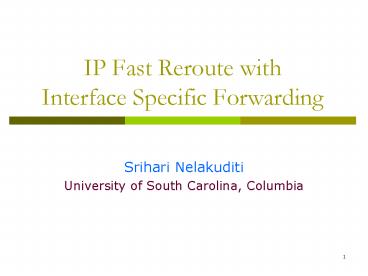IP Fast Reroute with Interface Specific Forwarding - PowerPoint PPT Presentation
1 / 15
Title:
IP Fast Reroute with Interface Specific Forwarding
Description:
Each line card has a copy of the same FIB. Interface-specific forwarding ... Requires stricter ordering than symmetric case. May need destination-specific ordering ... – PowerPoint PPT presentation
Number of Views:79
Avg rating:3.0/5.0
Title: IP Fast Reroute with Interface Specific Forwarding
1
IP Fast Reroute withInterface Specific Forwarding
- Srihari Nelakuditi
- University of South Carolina, Columbia
2
What is Interface Specific Forwarding?
- Interface-independent forwarding
- destination ? next-hop
- Each line card has a copy of the same FIB
- Interface-specific forwarding
- ltincoming interface, destinationgt ? next-hop
- Different forwarding entries at each line card
- Forwarding operation remains the same
3
ISF Enables Local Rerouting
- Infer failures based on interface and destination
- Find the farthest keylink whose failure would
cause a packet to arrive at the unusual interface
along the reverse shortest path to the
destination - Precompute interface-specific forwarding tables
- Avoid the keylink in choosing next hop for a
destination - Failure Inferencing based Fast Rerouting
- IP fast reroute without explicit routing/tunneling
4
Illustration No Failure Scenario
A A
C AE
D A
E E
F E
B B
C C
D D
E B
F B
5
Illustration Local Rerouting without ISF
A A
C A
D A
E A
F A
B B
C C
D D
E B
F B
6
Illustration Local Rerouting with ISF
A A
C A
D A
E A
F A
B -
C C
D D
E C
F D
B B
C C
D D
E B
F B
7
ISF Table Computation
- Infer failed links from packets arrival at an
interface - keylink whose failure causes packet to d
arrive at i from j - A link u?v is a candidate keylink if
- with u?v, j is a next hop from i to d
- without u?v, edge j?i is along the shortest path
from u to d - is the farthest one from i among candidate
keylinks - Avoid keylink in choosing the destinations next
hop - next hops to d from i when packet arrives
at i from j - Failure inferencing is not done per packet
- ISF table entries computed upon link state updates
8
Illustration ISF Table Computation
B -
C C
D D
E C
F D
B B
C -
D D
E B
F B
B B
C C
D -
E B
F B
When no more than one link failure is suppressed
in a network with symmetric weights, FIFR always
forwards successfully to a destination if a path
to it exists
9
Operations under FIFR
Event Adjacent nodes Other nodes
Packet arrival Interface-specific forwarding Interface-specific forwarding
Link down Initiate local rerouting
Link up before suppression interval Resume forwarding on the recovered link
Link down beyond suppression interval Link state update Recompute interface-specific forwarding tables
Link up after suppression interval Link state update Recompute interface-specific forwarding tables
10
Handling both Link and Node Failures
- Infer keynodes instead of keylinks
- A node u is a candidate keynode if
- with u, j is a next hop from i to d
- without u, edge j?i is along the shortest path
from the upstream node of u (w.r.t. the path from
i to u) to d - Keynode is the farthest one from i among
candidates - When no route to destination without a node
- Node adjacent to the failure assumes link failure
- Non-adjacent nodes treat it as adjacent node
failure - May cause loops when destination is indeed not
reachable - Protects against non-partitioning single failures
11
Networks with Asymmetric Link Weights
- FIFR can handle asymmetric link weights
- By forcing packets to take reverse shortest path
- Provided links are bidirectional
- Keynode computation based on rSPF
- A node u is a candidate keynode if
- with u, j is a next hop from i to d
- without u, edge i?j is along the shortest path
from d to the upstream node of u (w.r.t the path
from i to u) - Keynode is the farthest one from i among
candidates - Works with both symmetric and asymmetric weights
12
Networks with Broadcast Links
- FIFR applicable to networks with broadcast links
- A broadcast link is modeled with point to point
links from/to the designated router - Adjacent failures
- Broadcast link failure treated as that of
designated router - Non-adjacent failures
- Not necessary to know the previous hop of a
packet to compute interface-specific keynode per
destination - Failure inferencing can be done as before
13
Ordered FIB updating
- When link weights are symmetric
- Ordered FIB updating compatible with FIFR
- When link weights are asymmetric
- Requires stricter ordering than symmetric case
- May need destination-specific ordering
- Continuous loop-free forwarding with FIFR
14
Summary of FIFR
- Fast reroute under any single failures
- Without changing/encapsulating IP datagram
- May cause loops under multiple failures
- With ISF, guaranteed-protection against single
failures or loop-freedom under multiple failures
but not both - Blacklist-based Interface Specific Forwarding
- Needs interface-specific forwarding
- Two forwarding entries per destination
- O(Elog2V) to compute forwarding entries
15
FIFR Discussion
- Local repair for multicast
- Encapsulate multicast packet in a unicast packet
addressed to the next hop along the multicast
tree - Contrasting implicit FIFR and explicit not-via
- FIFR can not handle partitioning failures
- FIFR may have more no routes under SRLG failures
- FIFR with one additional bit
- Can protect against single failures
- Loop-free under multiple failures































